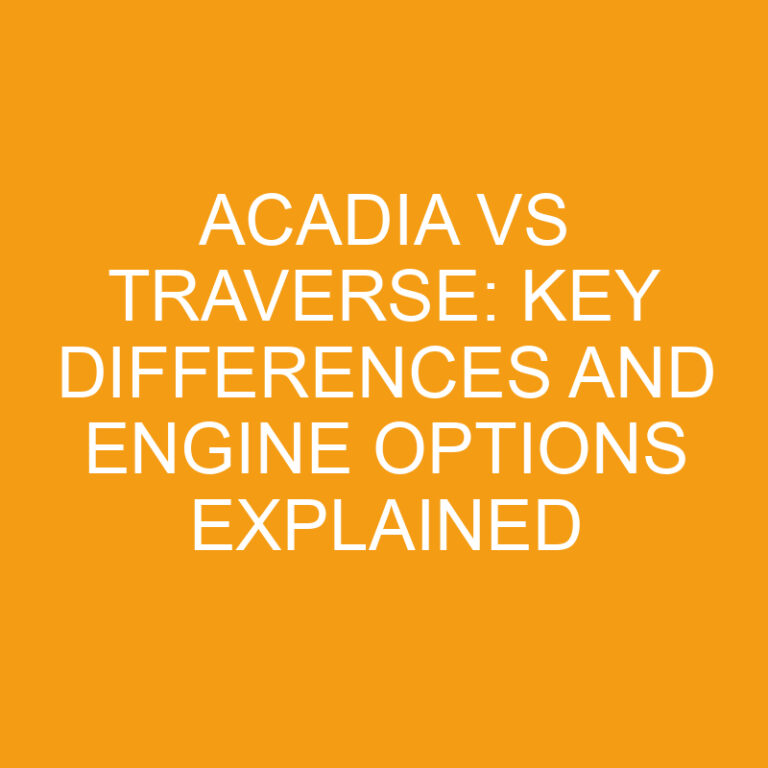
When it comes to choosing a vehicle with optimal traction and control, the decision often comes down to all-wheel drive (AWD) or four-wheel drive (4WD). These two terms are often used interchangeably, but they actually have distinct differences. As a car enthusiast, I’ve spent countless hours researching and comparing the benefits of AWD and 4WD. In this article, I’ll break down the key dissimilarities between these two drivetrain systems, so you can make an informed decision when it’s time to hit the road.
Picture this: you’re driving through a snowstorm, and you need maximum grip to navigate safely. That’s where all-wheel drive comes into play. AWD systems are designed to provide power to all four wheels simultaneously, ensuring enhanced traction and stability on slippery surfaces. On the other hand, four-wheel drive is commonly associated with off-road adventures and rugged terrains. 4WD systems are typically found in trucks and SUVs, allowing you to engage or disengage the extra power to the wheels when needed. In this article, I’ll delve deeper into the nuances of these drivetrain systems, giving you a comprehensive understanding of their capabilities and limitations.
Post Contents
- Key Takeaways
- What is All-Wheel Drive (AWD)?
- What is Four-Wheel Drive (4WD)?
- Key Differences Between AWD and 4WD
- Performance and Traction in AWD
- Off-Roading Capabilities of 4WD
- Is AWD or 4WD Better for Me?
- Conclusion
- Frequently Asked Questions
- What is the difference between all-wheel drive (AWD) and four-wheel drive (4WD)?
- Where is all-wheel drive (AWD) commonly found?
- Where is four-wheel drive (4WD) primarily found?
- How do the control mechanisms of AWD and 4WD differ?
- What are the advantages of all-wheel drive (AWD)?
- What are the trade-offs of all-wheel drive (AWD)?
- What are the off-roading capabilities of four-wheel drive (4WD)?
- Can four-wheel drive (4WD) vehicles be used on normal roads?
- How should I choose between all-wheel drive (AWD) and four-wheel drive (4WD)?
Key Takeaways
- All-wheel drive (AWD) provides power to all four wheels simultaneously, enhancing traction and stability on various road conditions.
- Four-wheel drive (4WD) is commonly found in off-road and rugged vehicles, allowing the driver to engage or disengage the extra power to the wheels when needed.
- AWD operates seamlessly and continuously, while 4WD requires driver input to engage or disengage the system.
- AWD is found in a wide range of vehicles, while 4WD is primarily found in trucks and SUVs.
- AWD improves handling, acceleration, and stability, making it ideal for everyday driving, while 4WD offers superior traction and control in off-road and challenging terrains.
- When deciding between AWD and 4WD, consider your specific driving needs and preferences.
What is All-Wheel Drive (AWD)?
When it comes to drivetrain systems, All-Wheel Drive (AWD) is a popular choice among car enthusiasts. As the name suggests, AWD is a system that provides power to all four wheels of a vehicle simultaneously. This means that each wheel receives a portion of the engine’s power, ensuring enhanced traction and stability on various road conditions.
The primary goal of AWD is to improve a vehicle’s handling and performance by distributing power to the wheels that have the most grip. This is especially beneficial in situations where there is limited traction, such as on wet, icy, or snow-covered roads. With AWD, all four wheels are actively engaged, allowing for better acceleration, cornering, and overall control.
One of the key advantages of AWD is its ability to automatically distribute power to the wheels that need it the most. Unlike four-wheel drive (4WD), which usually requires driver input to engage or disengage extra power to the wheels, AWD systems operate seamlessly and continuously. This makes AWD an ideal choice for everyday driving, providing an added layer of confidence and safety.
It’s important to note that not all AWD systems are created equal. Some vehicles may have a full-time AWD setup, where power is distributed to all four wheels at all times. Others may have a part-time AWD system, which allows the driver to manually switch between AWD and two-wheel drive modes.
AWD is a drivetrain system that provides power to all four wheels simultaneously, offering enhanced traction, stability, and control on various road conditions. With its automatic power distribution capability, AWD is a popular choice for those seeking a versatile and confidence-inspiring driving experience.
What is Four-Wheel Drive (4WD)?
Four-wheel drive (4WD) is a system that provides power to all four wheels of a vehicle simultaneously. This system is primarily found in off-road and rugged vehicles, such as trucks and SUVs.
4WD is designed to enhance a vehicle’s traction and control, particularly in challenging terrain or weather conditions. By supplying power to all four wheels, 4WD improves a vehicle’s ability to overcome obstacles and maintain grip on slippery or uneven surfaces.
Unlike all-wheel drive (AWD), which operates seamlessly and continuously, 4WD requires driver input to engage or disengage extra power to the wheels. This means that the driver has the flexibility to choose when they need the added traction of 4WD and when they can revert to a two-wheel drive mode for improved fuel efficiency.
There are different types of 4WD systems, including part-time and full-time setups.
- Part-time 4WD: This system allows the driver to manually engage or disengage 4WD as needed. When 4WD is engaged, power is distributed equally to all four wheels, providing optimal traction. However, it is important to disengage 4WD on dry or paved roads to prevent damage to the drivetrain.
- Full-time 4WD: This system is typically found in modern SUVs and luxury vehicles. Unlike part-time 4WD, full-time 4WD is always engaged and constantly sends power to each wheel. This allows for better traction and control in various road conditions without the need for driver intervention.
Overall, 4WD is a powerful and versatile system that is well-suited for off-road enthusiasts and drivers who regularly encounter challenging terrain. It offers the control and traction needed to tackle difficult conditions while giving drivers the flexibility to switch to two-wheel drive when necessary.
Key Differences Between AWD and 4WD
When it comes to traction and control, all-wheel drive (AWD) and four-wheel drive (4WD) are two popular systems that offer improved performance on different road conditions. Here are the key differences between AWD and 4WD:
Engagement
One of the main distinctions between AWD and 4WD is how they engage. AWD systems are designed to operate seamlessly and continuously, distributing power to all four wheels as needed. This means that AWD is always working to enhance traction and stability without any input from the driver. On the other hand, 4WD requires driver input to engage or disengage extra power to the wheels. This allows the driver to choose when they need the added traction of 4WD, making it a flexible option for challenging terrain or weather conditions.
Vehicle Applications
Another difference lies in the types of vehicles that are equipped with AWD and 4WD. AWD is commonly found in a wide range of vehicles, including sedans, SUVs, and even some sports cars. It’s a system that aims to enhance handling and performance on both dry and slippery surfaces. On the other hand, 4WD is primarily found in off-road and rugged vehicles, such as trucks and SUVs. It is built to tackle challenging terrains and provide maximum control in extreme conditions.
Control Mechanisms
The control mechanisms of AWD and 4WD systems also vary. AWD systems typically operate automatically, constantly monitoring wheel slippage and distributing power to the wheels with the most traction. This proactive approach ensures optimal performance in various driving situations. With 4WD, there are different control mechanisms available. Part-time 4WD allows the driver to manually engage or disengage 4WD as needed, giving them control over when to utilize the extra traction. Full-time 4WD, on the other hand, is always engaged and constantly sends power to each wheel, providing enhanced stability and control.
To summarize, the key differences between AWD and 4WD lie in their engagement, vehicle applications, and control mechanisms. AWD operates seamlessly and continuously, enhancing traction and stability without any driver input. It can be found in a wide range of vehicles and is designed to improve handling and performance. On the other hand, 4WD requires driver input to engage or disengage the system and is primarily found in off-road vehicles, providing maximum control in challenging terrain.
Performance and Traction in AWD
When it comes to performance and traction, all-wheel drive (AWD) truly shines. With its continuous power distribution to all four wheels, AWD ensures that you have optimal grip on the road at all times.
One of the primary advantages of AWD is its ability to improve handling and cornering. By sending power to the wheels with the most traction, AWD enhances stability and control, especially in challenging road conditions such as wet or icy surfaces. This means that AWD vehicles offer better maneuverability and responsiveness, allowing you to confidently navigate through various terrains.
In addition to improved handling, AWD also provides better acceleration. By effectively distributing power to all four wheels, an AWD system generates more traction, resulting in quicker acceleration and reduced wheel slippage. This is particularly beneficial when merging onto highways, passing slower vehicles, or driving uphill.
Moreover, AWD systems are always active and seamlessly adapt to the changing road conditions. They continuously monitor factors like wheel speed and throttle input to determine the optimal power distribution. As such, AWD offers superior stability, especially in situations where sudden changes in road conditions occur.
It’s worth noting that AWD is not just reserved for high-performance or luxury vehicles. Nowadays, you can find AWD systems in a wide range of vehicles, including sedans, SUVs, and even some crossovers. This means that you have more options to choose from when looking for a vehicle that offers exceptional performance and traction.
AWD is the ideal choice for those seeking enhanced performance and traction. With its seamless power distribution, improved handling, better acceleration, and superior stability, AWD ensures that you can confidently tackle various road conditions. It’s no wonder why AWD has become increasingly popular among car enthusiasts and everyday drivers alike.
However, it is important to note that the advantages of AWD come with some trade-offs, such as increased fuel consumption and higher maintenance costs. Therefore, it’s essential to consider your specific driving needs and priorities before deciding on whether AWD is the right choice for you.
Off-Roading Capabilities of 4WD
Four-wheel drive (4WD) systems are primarily designed to provide maximum control and traction in off-road and rugged terrains. The ability to engage or disengage extra power to all four wheels makes 4WD an ideal choice for off-roading enthusiasts like myself. Here’s why 4WD shines when it comes to venturing off the beaten path:
- Superior Traction: 4WD systems excel in challenging and slippery terrains. By sending power to all four wheels simultaneously, 4WD ensures that each wheel receives an equal share of torque. This evenly distributed power aids in conquering steep inclines, loose gravel, and muddy trails with ease.
- Increased Control: Off-roading often involves navigating through uneven surfaces, deep ruts, and obstacles. With 4WD, I have the option to engage or disengage the extra power to suit the specific terrain. This flexibility allows me to adapt to the changing conditions and maintain control over the vehicle, even in the most demanding situations.
- Enhanced Stability: The additional power directed to all four wheels contributes to improved stability and prevents wheel slippage. This stability ensures that each wheel maintains adequate traction, keeping the vehicle firmly planted on the ground. It helps reduce the risk of skidding or sliding, providing a safer off-roading experience.
- Maximum Torque: When tackling steep inclines or maneuvering through challenging obstacles, torque is crucial. 4WD systems deliver maximum torque to the wheels, providing the necessary power to overcome tough terrain. This torque not only helps with climbing uphill but also aids in descending safely and with control.
- Versatility: While 4WD is mainly associated with off-roading, it’s worth noting that many 4WD vehicles also perform admirably on normal roads. The option to disengage the additional power provides better fuel efficiency during regular commuting. This versatility is especially beneficial for those who enjoy both off-roading adventures and day-to-day driving.
Is AWD or 4WD Better for Me?
When choosing between all-wheel drive (AWD) and four-wheel drive (4WD), it’s important to consider your specific driving needs and priorities. Both systems have their own advantages and trade-offs, so let’s take a closer look at which one might be better for you.
AWD: Enhanced Performance and Traction
AWD operates seamlessly and continuously, distributing power to all four wheels as needed. This enhances traction, stability, control, and acceleration, making it ideal for various road conditions. Whether you’re driving on wet or slippery pavement or tackling a curvy mountain road, AWD adapts effortlessly to provide you with improved performance.
AWD systems are available in a wide range of vehicles, from sedans and SUVs to sports cars. This means you can enjoy the benefits of enhanced performance and traction regardless of the type of vehicle you prefer. However, it’s worth noting that AWD systems may come with increased fuel consumption and higher maintenance costs.
4WD: Unmatched Off-Roading Capabilities
If off-roading and rugged terrains are your passion, then 4WD might be the better option for you. 4WD systems are designed to provide maximum control, traction, and torque in challenging environments. By sending power to all four wheels simultaneously, 4WD ensures each wheel receives an equal share of torque, making it easier to conquer steep inclines, loose gravel, and muddy trails.
4WD vehicles excel at navigating through uneven surfaces, deep ruts, and obstacles. Their increased control and stability make them an ideal choice for off-roading adventures. The ability to disengage the extra power also allows 4WD vehicles to perform well on normal roads, providing better fuel efficiency during regular commuting.
The versatility of 4WD makes it a great option for those who enjoy both off-roading and day-to-day driving. However, it’s important to keep in mind that 4WD systems may not be as seamless or convenient as AWD systems when it comes to regular on-road driving.
When deciding between AWD and 4WD, consider your driving needs and preferences. If you prioritize enhanced performance, traction, and control in various road conditions, AWD might be the better choice. On the other hand, if you’re an avid off-roader who wants unmatched capabilities in challenging terrains, 4WD could be the way to go.
Conclusion
After discussing the key differences between all-wheel drive (AWD) and four-wheel drive (4WD) systems, it is clear that both options offer unique advantages depending on your driving needs. AWD provides enhanced performance and traction on various road conditions, adapting seamlessly to changing environments. It is available in a wide range of vehicles and aims to improve handling and stability. However, it’s important to consider the trade-offs of increased fuel consumption and higher maintenance costs.
On the other hand, 4WD excels in off-roading and rugged terrains, offering maximum control and traction. It provides unmatched stability and torque, making it ideal for conquering challenging obstacles and uneven surfaces. Additionally, 4WD vehicles can be disengaged for better fuel efficiency during regular commuting.
Ultimately, the choice between AWD and 4WD depends on your specific driving preferences and priorities. If you prioritize enhanced performance and traction on various road conditions, AWD is the way to go. However, if you enjoy off-roading adventures and need maximum control and stability in challenging terrains, 4WD is the better option. Consider your driving needs and make an informed decision based on what suits you best.
Frequently Asked Questions
What is the difference between all-wheel drive (AWD) and four-wheel drive (4WD)?
AWD operates seamlessly and continuously, distributing power to all four wheels as needed. 4WD requires driver input to engage or disengage extra power to the wheels.
Where is all-wheel drive (AWD) commonly found?
AWD is commonly found in a wide range of vehicles, including sedans, SUVs, and crossover vehicles.
Where is four-wheel drive (4WD) primarily found?
4WD is primarily found in off-road and rugged vehicles designed for challenging terrains.
How do the control mechanisms of AWD and 4WD differ?
AWD systems operate automatically, distributing power to all wheels as needed. 4WD systems offer both part-time and full-time engagement options, requiring driver input.
What are the advantages of all-wheel drive (AWD)?
AWD offers improved performance, traction, stability, control, and acceleration on various road conditions. It adapts seamlessly to changing road conditions.
What are the trade-offs of all-wheel drive (AWD)?
AWD may result in increased fuel consumption and higher maintenance costs.
What are the off-roading capabilities of four-wheel drive (4WD)?
4WD provides maximum control and traction in off-road and rugged terrains. It excels in challenging and slippery conditions.
Can four-wheel drive (4WD) vehicles be used on normal roads?
Yes, 4WD vehicles can be disengaged for better fuel efficiency during regular commuting.
How should I choose between all-wheel drive (AWD) and four-wheel drive (4WD)?
Consider your specific driving needs and priorities. If you prioritize enhanced performance and traction on various road conditions, choose AWD. If you prioritize off-roading capabilities, choose 4WD.






